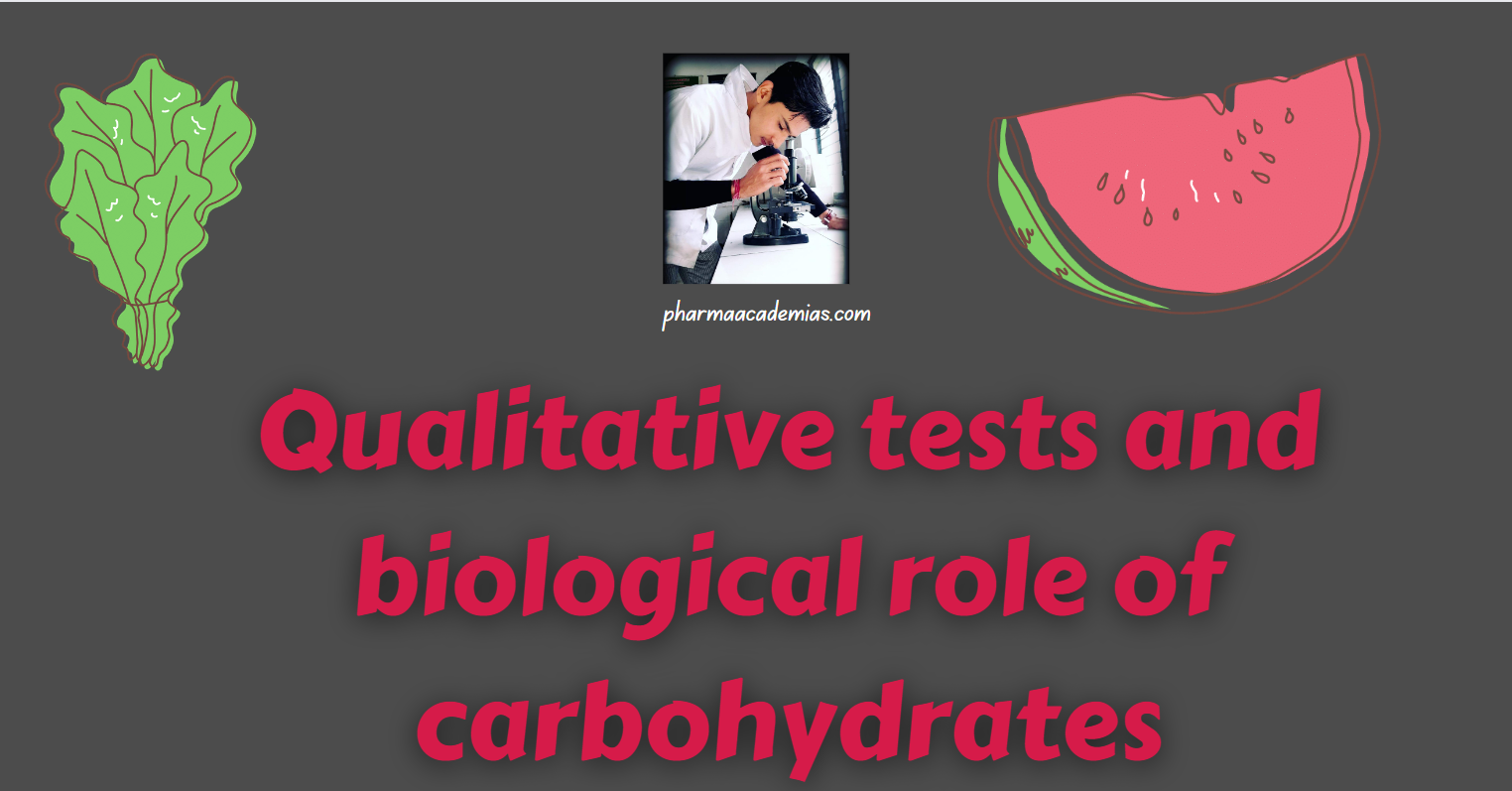Qualitative tests for carbohydrates involve detecting the presence of specific functional groups or characteristics indicative of different types of carbohydrates. Here are some common qualitative tests for carbohydrates:
1. Benedict’s Test (Reducing Sugars)
Principle: Detects reducing sugars that can reduce copper ions (Cu²⁺) to form a colored precipitate.
Procedure: A sample is mixed with Benedict’s reagent and heated. A color change from blue to green, yellow, orange, or red indicates the presence of reducing sugars.
2. Iodine Test (Starch)
Principle: Iodine interacts with the helical structure of starch, forming a blue-black complex.
Procedure: Iodine solution is added to the sample. A color change to blue-black indicates the presence of starch.
3. Fehling’s Test (Reducing Sugars)
Principle: Like Benedict’s test, Fehling’s reagent detects reducing sugars by reducing copper ions.
Procedure: A sample is mixed with Fehling’s reagent and heated. The formation of a red precipitate indicates a positive result.
4. Molisch’s Test (General Carbohydrates)
Principle: Concentrated sulfuric acid dehydrates carbohydrates, forming a complex with α-naphthol.
Procedure: A sample is mixed with α-naphthol and then treated with sulfuric acid. The appearance of a violet ring at the junction of the two liquids indicates the presence of carbohydrates.
5. Barfoed’s Test (Monosaccharides)
Principle: Differentiates between monosaccharides and disaccharides based on the rate of reduction of copper ions.
Procedure: A sample is mixed with Barfoed’s reagent and heated. Monosaccharides give a positive result faster than disaccharides, producing a brick-red precipitate.
6. Seliwanoff’s Test (Ketoses)
Principle: Differentiate between aldoses and ketoses based on the reaction rate with resorcinol in the presence of concentrated hydrochloric acid.
Procedure: A sample is mixed with resorcinol and hydrochloric acid. Ketoses give a positive result faster than aldoses, resulting in a cherry-red color.
7. Osazone Test (Glucose and Mannose)
Principle: Formation of crystalline osazones from the reaction between reducing sugars and phenylhydrazine.
Procedure: A sample is reacted with phenylhydrazine hydrochloride and sodium acetate. Crystalline osazones that form are indicative of the presence of glucose or mannose.
These tests provide qualitative information about the presence or absence of specific types of carbohydrates based on their structural and chemical characteristics.
Biological role of carbohydrate
Carbohydrates play crucial biological roles in living organisms, serving as essential macromolecules with diverse functions. Some key biological roles of carbohydrates include:
1. Energy Source
Glucose Metabolism: Carbohydrates, especially glucose, are a primary energy source for cellular processes through glycolysis and cellular respiration.
Energy Storage: The body converts excess glucose into glycogen (in animals) or starch (in plants) for short-term energy storage.
2. Structural Support
Cellulose: Found in the cell walls of plants, cellulose provides structural support and rigidity to plant cells.
Chitin: Present in the exoskeletons of arthropods and the cell walls of fungi, chitin provides structural support and protection.
3. Cellular Communication
Cell Surface Markers: Carbohydrates on cell surfaces, often in the form of glycoproteins and glycolipids, play a role in cell recognition, signaling, and communication.
Blood Type Determination: Specific carbohydrates on the surface of red blood cells determine ABO blood groups.
4. Nucleic Acid Structure
Ribose and Deoxyribose: Carbohydrates are integral components of nucleic acids (RNA and DNA), where ribose and deoxyribose sugars form the backbone of these molecules.
5. Immune Response
Antigens: Carbohydrates on the surface of pathogens can act as antigens, triggering immune responses. For example, the O-antigen of lipopolysaccharides in bacterial cell walls.
6. Cell Adhesion
Glycoproteins: Carbohydrates on the surface of cells, often in the form of glycoproteins, contribute to cell adhesion and recognition in various physiological processes.
7. Dietary Fiber
Digestive Health: Carbohydrates in dietary fiber, such as cellulose and hemicellulose, contribute to digestive health by promoting regular bowel movements and preventing constipation.
8. Energy Storage in Seeds
Starch: Plants store energy as starch in seeds, providing a nutrient reserve for germination and early seedling growth.
9. Glycocalyx Function
Cell Surface Protection: The glycocalyx, composed of carbohydrates on the cell surface, protects against physical and chemical stresses and plays a role in cell recognition.
10. Glycolysis Regulation
Feedback Mechanism: Glucose and other carbohydrates regulate the glycolytic pathway, influencing the rate of cellular energy production.
These diverse roles highlight the importance of carbohydrates in the structure, function, and regulation of biological processes in organisms across the tree of life. Carbohydrates contribute significantly to the complexity and versatility of life’s molecular machinery.

